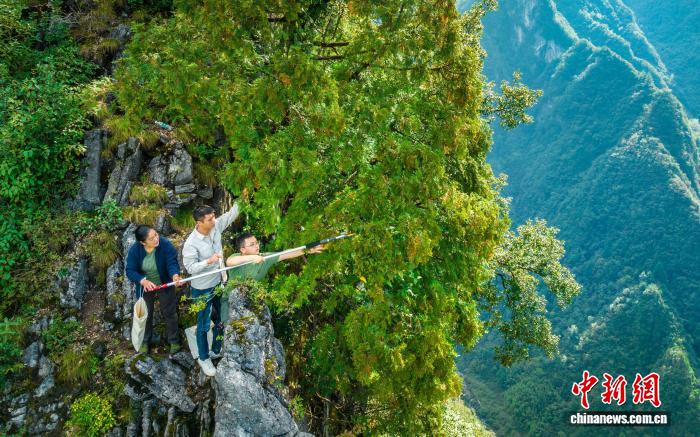Chongqing – The Chongqing Forestry Bureau and the Kaizhou District government have jointly signed a cooperation agreement to coordinate the formulation of technical standards including the “Thuja Sutchuenensis Seedling Breeding Technical Regulations” and “Thuja Sutchuenensis Planting Technical Regulations,” marking the launch of China’s Thuja Sutchuenensis protection technical standards development in Chongqing.
Thuja Sutchuenensis is known as the “giant panda” of the plant kingdom, belonging to China’s unique rare and endangered plant species. It flourished during the Cretaceous period but was later declared “extinct in the wild” due to climate change and human activities, until its rediscovery in 1999.
The signed cooperation agreement proposes to collaborate with research institutions and universities to actively establish a Thuja Sutchuenensis key laboratory, conducting basic research on genetic characteristics, endangered mechanisms, and propagation techniques.
Simultaneously, a “Thuja Sutchuenensis+” full industrial chain development path will be implemented, developing high-value-added products such as fragrances and medicinal extracts; constructing Thuja Sutchuenensis-themed wellness bases and ecological research camps to further strengthen the protection and sustainable utilization of the plant’s native habitat, jointly building an integrated development system for Thuja Sutchuenensis resource protection, research, industry, and culture.
Currently, Chongqing has successfully developed over 10 ecological products in the Thuja Sutchuenensis industry, including essential oils and hair conditioners, with cumulative registration of 68 related intellectual properties and more than 120 derivative product trademarks.
The Chongqing Xuebaoshan National Nature Reserve serves as the main native habitat and core distribution area for Thuja Sutchuenensis, with wild specimens discovered in and around the reserve accounting for over 70% of the national total. The reserve has pioneered breakthroughs in large-scale propagation technology, establishing China’s largest Thuja Sutchuenensis breeding base, with cumulative propagation of over 3 million seedlings and more than 750,000 plants reintroduced to the wild, successfully reversing the endangered status and providing a “Chongqing solution” for global endangered species protection.
To expand wild population numbers, Thuja Sutchuenensis relocation protection has covered 17 provinces including Yunnan, Ningxia, and Inner Mongolia, with an average survival rate exceeding 85%, providing new tree species options for ecological restoration in arid and semi-arid regions. Additionally, Kaizhou District has established China’s first regional Thuja Sutchuenensis germplasm resource database, currently registering 7,900 wild specimens.
Chongqing Forestry Bureau
The Chongqing Forestry Bureau is a government administrative body responsible for managing and conserving forest resources within the Chongqing municipality in China. It was established to oversee forest protection, afforestation projects, and sustainable development in the region, particularly as part of broader national environmental initiatives. Its work focuses on combating soil erosion and preserving biodiversity in the ecologically significant Yangtze River basin.
Kaizhou District government
Kaizhou District is a municipal district of Chongqing, China, with a history dating back over a thousand years. The Kaizhou District government is the local administrative body responsible for the area’s governance and development. It manages public services and implements policies for the district’s urban and rural communities.
Thuja Sutchuenensis Seedling Breeding Technical Regulations
This is not a place or cultural site, but a technical agricultural document. It is a set of standardized procedures and guidelines for the cultivation and breeding of the Thuja sutchuenensis, a rare and endangered species of conifer tree native to China. The regulations were developed to ensure the species’ conservation and successful propagation, as it was once thought to be extinct in the wild.
Thuja Sutchuenensis Planting Technical Regulations
This is not a place or cultural site, but a technical document. The “Thuja Sutchuenensis Planting Technical Regulations” is a set of scientific guidelines for the cultivation of the critically endangered Szechuan thuja tree. It was created to aid in the conservation and restoration efforts for this species, which was once thought to be extinct but was rediscovered in China.
Thuja Sutchuenensis key laboratory
The Thuja Sutchuenensis Key Laboratory is a research institution in China dedicated to the study and conservation of the critically endangered Thuja sutchuenensis, also known as the Sichuan thuja. This species of conifer was rediscovered in the late 20th century after being thought extinct for over a century. The laboratory’s work focuses on understanding its biology, promoting its propagation, and protecting its remaining natural habitat.
Chongqing Xuebaoshan National Nature Reserve
The Chongqing Xuebaoshan National Nature Reserve is a protected mountainous area in Chongqing Municipality, renowned for its stunning alpine landscapes, diverse plant life, and rare animal species like the giant salamander. Its history is deeply tied to local Taoist culture, with the Xuebao Mountain itself being a sacred site home to ancient temples. The area was designated as a national nature reserve to conserve this unique natural and cultural heritage.
Thuja Sutchuenensis breeding base
The Thuja sutchuenensis breeding base is a conservation facility dedicated to the preservation of the critically endangered Sichuan thuja (or Cupressus sutchuenensis). This conifer species, once thought to be extinct in the wild, was rediscovered in China in 1999. The base focuses on cultivating seedlings and studying the tree to ensure its survival and eventual reintroduction into its native habitat.
Thuja Sutchuenensis germplasm resource database
The Thuja sutchuenensis Germplasm Resource Database is a specialized conservation initiative focused on the critically endangered Sichuan thuja tree. It systematically collects and preserves genetic material, propagation data, and ecological information about this species, which was rediscovered in China in 1999 after being presumed extinct for over a century. This database supports scientific research and conservation efforts to protect the remaining wild populations of this ancient conifer.




